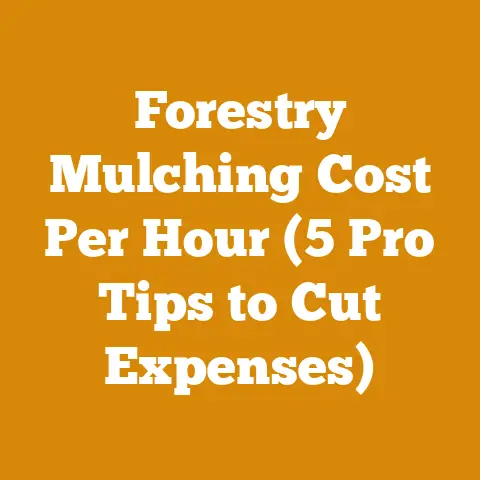How Long Does It Take for Timber to Regrow? (Forestry Insights)
I still remember the first time I smelled freshly cut pine.
I was a kid, tagging along with my grandfather in his woodlot.
The scent was intoxicating, a promise of warmth and the satisfaction of honest work.
We weren’t just cutting trees; we were participating in a cycle, taking what we needed responsibly and knowing that the forest would, in time, renew itself.
This memory, and countless others like it, fuels my passion for understanding the delicate balance of forestry and sustainable wood use.
How Long Does It Take for Timber to Regrow? (Forestry Insights)
The question of how long it takes for timber to regrow is deceptively simple.
The answer depends on a whole host of factors, from the species of tree to the climate it’s growing in, the management practices employed, and even the unpredictable hand of nature.
This isn’t a “one-size-fits-all” scenario, but understanding the underlying principles can help you make informed decisions, whether you’re a homeowner planting a few trees, a small-scale firewood producer, or a professional logger.
Currently, the global timber market is experiencing fluctuating demands, driven by construction, paper production, and the increasing popularity of wood as a sustainable building material.
Sustainable forestry practices are more critical than ever.
According to the Food and Agriculture Organization of the United Nations (FAO), approximately 10 million hectares of forest are lost each year due to deforestation.
However, sustainably managed forests are increasing in some regions, demonstrating a growing commitment to responsible forestry.
This makes understanding regrowth rates even more vital.
Understanding the Key Concepts
Before diving into specific timelines, let’s define some essential terms:
- Timber: Wood that is ready for use as lumber or other products.
- Regrowth: The process of trees regenerating and growing to a harvestable size after being cut down.
- Rotation Length: The time it takes for a stand of trees to reach maturity and be ready for harvest.
- Green Wood: Newly cut wood with high moisture content.
- Seasoned Wood: Wood that has been dried to reduce its moisture content, making it suitable for burning or construction.
- Sustainable Forestry: Forest management practices that aim to maintain the health and productivity of forests for future generations.
Factors Influencing Timber Regrowth Rates
Several factors influence how quickly timber regrows:
- Tree Species: Different tree species have drastically different growth rates.
- Fast-Growing Species: Poplar, willow, and pine can reach maturity in as little as 20-30 years.
- Slow-Growing Species: Oak, maple, and walnut can take 80-120 years or even longer to mature.
- Climate: Temperature, rainfall, and sunlight all play a crucial role in tree growth.
Warmer climates with ample rainfall generally support faster growth rates. - Soil Quality: Nutrient-rich soil provides the building blocks for healthy tree growth.
- Forest Management Practices: Practices like thinning, fertilization, and weed control can significantly impact growth rates.
- Competition: The presence of other trees and plants can compete for resources, slowing down growth.
- Pests and Diseases: Infestations and diseases can weaken or kill trees, hindering regrowth.
- Natural Disasters: Wildfires, storms, and floods can set back regrowth efforts.
Detailed Look at Regrowth Timelines by Species
Let’s examine the regrowth timelines for some common timber species:
1. Pine (Various Species):
- Typical Rotation Length: 25-50 years, depending on the species and management practices.
- Growth Rate: Relatively fast.
Pine trees can grow several feet per year in optimal conditions. - Firewood Quality: Moderate.
Pine burns quickly and produces a good amount of heat, but it also creates more smoke and creosote buildup. - Unique Insights: Pine is often used for pulpwood and softwood lumber.
It’s a popular choice for reforestation due to its rapid growth. - Case Study: In the southeastern United States, loblolly pine plantations managed for pulpwood often have rotation lengths of around 25-30 years.
- Cost: Pine seedlings are relatively inexpensive, making it a cost-effective choice for reforestation.
- Troubleshooting: Pine is susceptible to pine beetles.
Monitor your trees regularly and take preventative measures if necessary. - Actionable Tip: When planting pine, ensure proper spacing to allow for adequate sunlight and air circulation.
- Idiom: “Quick as a pine tree shooting up” – emphasizes the rapid growth of pine.
2. Poplar (Various Species):
- Typical Rotation Length: 10-20 years.
- Growth Rate: Very fast. Poplar trees are among the fastest-growing trees in the world.
- Firewood Quality: Poor.
Poplar burns very quickly and produces little heat.
It’s best used as kindling or avoided altogether. - Unique Insights: Poplar is often used for biomass energy production and fast-growing plantations.
- Case Study: Hybrid poplar plantations in the Pacific Northwest are often harvested on a 10-year rotation for pulpwood.
- Cost: Poplar cuttings are easy to propagate and relatively inexpensive.
- Troubleshooting: Poplar is susceptible to diseases like leaf spot.
Ensure good air circulation to minimize disease risk. - Actionable Tip: Poplar thrives in moist, well-drained soil.
- Idiom: “Growing like a poplar in spring” – highlights the rapid growth spurt.
3. Oak (Various Species):
- Typical Rotation Length: 80-120 years or longer.
- Growth Rate: Slow. Oak trees are slow-growing, especially in their early years.
- Firewood Quality: Excellent.
Oak burns slowly and produces a high amount of heat.
It’s a popular choice for firewood. - Unique Insights: Oak is prized for its strong, durable wood, used in furniture, flooring, and construction.
- Case Study: White oak is often managed on a long rotation for high-quality lumber in the Appalachian region.
- Cost: Oak seedlings are more expensive than pine or poplar.
- Troubleshooting: Oak is susceptible to oak wilt.
Preventative measures include avoiding pruning during the growing season. - Actionable Tip: Protect young oak trees from deer browsing.
- Idiom: “Strong as an oak” – emphasizes the strength and longevity of oak.
4. Maple (Various Species):
- Typical Rotation Length: 60-100 years.
- Growth Rate: Moderate.
Maple trees grow at a moderate pace, faster than oak but slower than pine. - Firewood Quality: Good. Maple burns well and produces a good amount of heat.
- Unique Insights: Maple is prized for its beautiful grain pattern, used in furniture and flooring.
Sugar maple is also tapped for maple syrup production. - Case Study: Sugar maple stands in New England are often managed for both timber and maple syrup production.
- Cost: Maple seedlings are moderately priced.
- Troubleshooting: Maple is susceptible to maple decline, a complex syndrome that can weaken or kill trees.
- Actionable Tip: Ensure adequate drainage to prevent root rot.
- Idiom: “Sweet as maple syrup” – references the sugar maple’s valuable sap.
5. Walnut (Various Species):
- Typical Rotation Length: 80-120 years or longer.
- Growth Rate: Slow. Walnut trees are slow-growing, especially in their early years.
- Firewood Quality: Excellent.
Walnut burns slowly and produces a high amount of heat.
It also has a pleasant aroma. - Unique Insights: Walnut is prized for its dark, rich-colored wood, used in furniture, gun stocks, and veneer.
- Case Study: Black walnut plantations are often managed on a long rotation for high-quality lumber in the Midwest.
- Cost: Walnut seedlings are relatively expensive.
- Troubleshooting: Walnut is susceptible to walnut anthracnose, a fungal disease that can cause leaf spot and defoliation.
- Actionable Tip: Provide walnut trees with plenty of sunlight and well-drained soil.
- Idiom: “Worth its weight in walnut” – signifies the high value of walnut wood.
Forestry Tools and Techniques for Optimizing Regrowth
Here’s a breakdown of tools and techniques to consider:
Chainsaws vs.
Axes:- Chainsaws: Efficient for felling larger trees and processing timber.
Modern chainsaws are lighter, more powerful, and safer than ever.
Brands like Stihl and Husqvarna are widely respected for their quality and reliability. - Axes: Useful for smaller trees, clearing brush, and splitting firewood.
Axes are more physically demanding but can be a sustainable choice for small-scale operations. - Recommendation: For larger-scale logging, a chainsaw is essential.
For smaller-scale firewood production or clearing brush, an axe can be a viable option.
I often use a chainsaw for felling and bucking, but I prefer an axe for splitting smaller rounds.
- Chainsaws: Efficient for felling larger trees and processing timber.
-
Felling Techniques:
- Directional Felling: Carefully planning the direction of the fall to minimize damage to surrounding trees and ensure safety.
- Undercut and Back Cut: Creating a notch on the side of the tree in the desired direction of fall, followed by a back cut to sever the tree.
- Safety Considerations: Always wear appropriate safety gear, including a helmet, eye protection, hearing protection, and chainsaw chaps.
- Step-by-Step Guide:
- Assess the tree and surrounding area for hazards.
- Plan the direction of fall.
- Create an undercut on the side of the tree in the desired direction of fall.
- Make a back cut slightly above the undercut, leaving a hinge.
- Use wedges if necessary to guide the fall.
- Retreat to a safe distance as the tree falls.
-
De-limbing Procedures:
- Using a Chainsaw: Efficient for removing branches from felled trees.
- Using an Axe: Useful for smaller branches and brush.
- Safety Considerations: Maintain a stable stance and avoid cutting above your head.
- Step-by-Step Guide:
- Start at the base of the tree and work your way up.
- Cut branches close to the trunk.
- Avoid cutting into the trunk.
- Be aware of springback from branches under tension.
-
Thinning:
- Purpose: Removing some trees to allow the remaining trees to grow faster.
- Timing: Typically done when the trees are young and competing for resources.
- Technique: Select trees to remove based on species, health, and spacing.
- Benefit: Improves the overall health and productivity of the forest.
-
Fertilization:
- Purpose: Providing trees with essential nutrients to promote growth.
- Timing: Typically done in the spring or fall.
- Technique: Apply fertilizer around the base of the trees.
- Benefit: Can significantly increase growth rates, especially in nutrient-poor soils.
-
Weed Control:
- Purpose: Reducing competition from weeds and other vegetation.
- Timing: Typically done in the spring or summer.
- Technique: Use herbicides or manual removal to control weeds.
- Benefit: Allows trees to access more resources and grow faster.
The Art and Science of Firewood Preparation
Firewood preparation is more than just chopping wood; it’s a craft that requires knowledge, skill, and a bit of elbow grease.
Splitting Logs:
- Tools: Axes, splitting mauls, hydraulic log splitters.
- Technique: Aim for the natural cracks in the wood.
Use a splitting maul for larger logs and an axe for smaller rounds.
Hydraulic log splitters are efficient for processing large quantities of wood. - Step-by-Step Guide:
- Place the log on a stable surface.
- Position the splitting tool on the log.
- Strike the tool with force.
- Repeat until the log is split.
- Safety Considerations: Wear eye protection and gloves.
Maintain a stable stance.
-
Seasoning Firewood:
- Purpose: Reducing the moisture content of the wood to improve its burning efficiency.
- Target Moisture Content: 20% or less.
- Technique: Stack the wood in a well-ventilated area, off the ground, and covered from rain.
- Step-by-Step Guide:
- Split the wood into manageable sizes.
- Stack the wood in rows, allowing for air circulation.
- Elevate the wood off the ground using pallets or other materials.
- Cover the top of the stack with a tarp to protect it from rain.
- Allow the wood to season for at least six months, preferably longer.
- Data Point: Seasoning firewood for 6-12 months can reduce its moisture content from 50% to 20% or less.
- Case Study: I’ve found that stacking firewood in a south-facing location with good airflow significantly reduces seasoning time.
- Actionable Tip: Use a moisture meter to check the moisture content of the wood before burning it.
- Idiom: “Patience is a virtue, especially when seasoning firewood.”
Wood Stacking Techniques:
- Purpose: Creating stable and efficient firewood stacks.
- Cord: A standard unit of measurement for firewood, equal to 128 cubic feet.
- Techniques:
- Holz Hausen: A circular stack that promotes good airflow and stability.
- Linear Stacks: Simple rows of wood that are easy to build.
- Step-by-Step Guide (Linear Stack):
- Choose a level location.
- Lay down a base of pallets or other materials to elevate the wood off the ground.
- Stack the wood in rows, alternating the direction of the logs to create stability.
- Leave gaps between the rows for air circulation.
- Cover the top of the stack with a tarp.
- Cost: Pallets are often free or inexpensive.
Tarps can be purchased at hardware stores. - Troubleshooting: Stacks can collapse if they are not built properly.
Ensure a stable base and proper interlocking of the logs. - Actionable Tip: Build your firewood stacks in a location that is convenient for access during the winter months.
- Idiom: “A well-stacked woodpile is a sign of preparedness.”
Costs, Budgeting, and Resource Management
Effective cost management is crucial for any wood processing or firewood preparation project:
-
Tool Costs:
- Chainsaws: Prices range from $200 for a basic model to $1000 or more for a professional-grade saw.
- Axes: Prices range from $50 to $200.
- Splitting Mauls: Prices range from $75 to $150.
- Hydraulic Log Splitters: Prices range from $500 to $3000 or more.
- Safety Gear: Budget at least $100 for a helmet, eye protection, hearing protection, and chainsaw chaps.
-
Material Costs:
- Firewood: Prices vary depending on the region and the type of wood.
- Pallets: Often free or inexpensive.
- Tarps: Prices range from $20 to $100, depending on the size and quality.
- Fertilizer: Prices vary depending on the type of fertilizer.
- Herbicides: Prices vary depending on the type of herbicide.
-
Labor Costs:
- Self-Labor: Consider the value of your time when budgeting for projects.
- Hired Labor: If you hire someone to help with the work, factor in their hourly rate.
-
Resource Management Tips:
- Use Sustainable Forestry Practices: Harvest timber responsibly and replant trees to ensure the long-term health of the forest.
- Minimize Waste: Use all parts of the tree, including branches and bark, for firewood, mulch, or other purposes.
- Recycle Materials: Reuse pallets and other materials whenever possible.
- Conserve Energy: Use efficient tools and techniques to minimize energy consumption.
Troubleshooting and Common Pitfalls
Even with careful planning, things can go wrong.
Here are some common pitfalls to avoid:
-
Improper Felling Techniques: Can result in injury or damage to property.
- Solution: Take a felling course and practice proper techniques.
-
Dull Chainsaw: Makes cutting difficult and increases the risk of kickback.
- Solution: Sharpen your chainsaw regularly.
-
Wet Firewood: Difficult to ignite and produces little heat.
- Solution: Season your firewood properly.
-
Unstable Firewood Stacks: Can collapse and cause injury.
- Solution: Build your firewood stacks properly.
-
Ignoring Safety Precautions: Can result in serious injury.
- Solution: Always wear appropriate safety gear and follow safety guidelines.
Next Steps and Additional Resources
Now that you have a better understanding of timber regrowth and firewood preparation, here are some next steps you can take:
- Assess Your Needs: Determine your goals and objectives.
Are you interested in managing a woodlot for timber production, producing firewood for your own use, or something else? - Develop a Plan: Create a detailed plan that outlines your goals, timelines, and budget.
- Gather Resources: Acquire the necessary tools, materials, and knowledge.
- Start Small: Begin with a small project to gain experience and build confidence.
- Seek Advice: Consult with experienced foresters, loggers, or firewood producers.
Additional Resources:
- Local Forestry Agencies: Provide information and assistance on forest management.
- Chainsaw and Logging Tool Suppliers: Stihl, Husqvarna, Baileys.
- Firewood Drying Equipment Rental Services: Local equipment rental companies.
- Online Forums and Communities: Connect with other wood processing and firewood enthusiasts.
Final Thoughts
Understanding how long it takes for timber to regrow is essential for sustainable forestry and responsible wood use.
By considering the factors that influence growth rates and employing appropriate management practices, we can ensure that our forests continue to provide us with valuable resources for generations to come.
Whether you’re a seasoned professional or a weekend warrior, I hope this guide has provided you with the knowledge and inspiration you need to succeed in your wood processing and firewood preparation endeavors.
Remember, the journey of a thousand board feet begins with a single seed!






